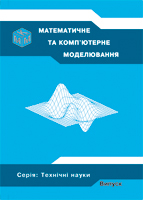ПРО ОДИН МЕТОД РОЗВ’ЯЗУВАННЯ КРАЙОВОЇ ЗАДАЧІ ДЛЯ ЗВИЧАЙНИХ ДИФЕРЕНЦІАЛЬНИХ РІВНЯНЬ З ІМПУЛЬСНИМ ВПЛИВОМ І ПАРАМЕТРАМИ
DOI:
https://doi.org/10.32626/2308-5878.2009-2.111-120Ключові слова:
крайова задача, диференціальні рівняння, інтегральне рівняння, колокаційно-ітеративний метод, імпульсний вплив.Анотація
Розглядається питання застосування колокаційно-ітеративного методу до розв’язування крайових задач для звичайних диференціальних рівнянь з імпульсним впливом та параметрами. Побудовано алгоритм методу, наведена обчислювальна схема.Посилання
Самойленко А. М. Численно-аналитические методы в теории краевых задач обыкновенных дифференциальных уравнений / А. М. Самойленко, Н. И. Ронто. — К. : Наук. думка, 1992. — 280 с.
Лучка А. Ю. Крайова задача для диференціальних рівнянь з імпульсною дією і побудова її розв’язку проекційним методом / А. Ю. Лучка // Доповіді АН України. — 1993. — № 8. — C. 11—16.
Лучка А. Ю. Застосування проекційно-ітеративного методу до крайової задачі для диференціальних рівнянь з імпульсною дією / А. Ю. Лучка // Доповіді АН України. — 1993. — № 9. — C. 10—14.
##submission.downloads##
Опубліковано
2009-03-30
Номер
Розділ
Статті
Ліцензія
Authors who publish with this journal agree to the following terms:- Authors retain copyright and grant the journal right of first publication with the work simultaneously licensed under a Creative Commons Attribution License that allows others to share the work with an acknowledgement of the work's authorship and initial publication in this journal.
- Authors are able to enter into separate, additional contractual arrangements for the non-exclusive distribution of the journal's published version of the work (e.g., post it to an institutional repository or publish it in a book), with an acknowledgement of its initial publication in this journal.
- Authors are permitted and encouraged to post their work online (e.g., in institutional repositories or on their website) prior to and during the submission process, as it can lead to productive exchanges, as well as earlier and greater citation of published work (See The Effect of Open Access).

